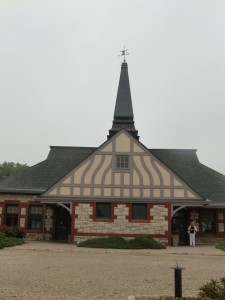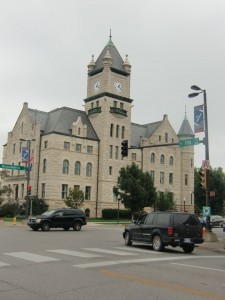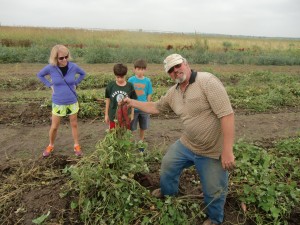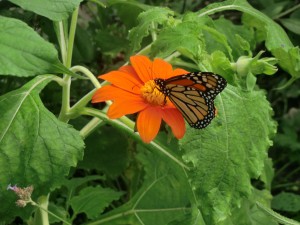ROAMING AROUND KANSAS – LAWRENCE: THE UNIVERSITY TOWN
ROAMING AROUND KANSAS
This is the 9th in a series of articles about touring the state of Kansas
LAWRENCE: THE UNIVERSITY TOWN
By Charles N. Stevens
Photos by Dolores Seidman
Again we look up at a blanket of morning low clouds and fog. It’s cool enough for exercise, so we take a brisk walk to get our blood flowing. About 8:30 our bus pulls out for a short trip to an old Union Pacific station.
The station looks, at first, much like a church because of its tall pointed steeple located near its center. I had never seen a railroad station designed like this one. No longer serving passengers, the station is used for a visitors center containing many displays about the history of the area. We settle down for a film about Kansas history then tour the exhibits. A train of empty coal cars rumbles by the station, the locomotive’s horn sounding a loud two-tone blast.
Near downtown Lawrence we visit the Watkins Museum, a three-story building built in the Richardsonian Romanesque style with its circular stone arch over the entrance. Completed in 1888, it once housed the Watkins National Bank. It also served as a city hall before becoming a museum. The building looks solid and impregnable, which was once a comfort to those who deposited money there. We spend an hour perusing the exhibits on all three floors, learning much more about Lawrence and the history of Kansas.
Prominently displayed in the museum was information about Quantrill’s Raiders, a force of over 400 men that raided Lawrence in 1863 during the Civil War. The raiders swept in at dawn in August of that year, burning down most of the town and killing an estimated 160 to 190 men. Quantrill led his men from Missouri, a slave state, into Lawrence, Kansas, a free state. Earlier we had seen several houses in Lawrence where men had once been called out by the raiders and brutally shot. Seeing these houses, now so peaceful looking, and imagining what had happened on that very tree-shaded street so long ago, gives me a chill. The Mount Calvary Cemetery contains several graves of the men killed on that day as well as a monument dedicated to all those that died that terrible morning.
From the museum we walk into town on the main street looking for a place for lunch. We settle on the Pita Pit where Dolores orders a gyro and I falafel wrapped in pita bread. Delightful!
Continuing our stroll through town, we walk into the old Eldridge Hotel, its lobby rather gloomy with dark polished woods and overstuffed furniture. For a more aesthetic venture, we tour the brand new city library, beautifully done with long strips like wood on the outside and polished light wood on the inside.
Once more gathering in the bus, we leave town for the rural outskirts where we’ll visit a farm, the Pendleton Farms and Store. One of the first sights I see after getting off the bus is a cat playing with a large mouse that it had caught, earning his keep. The farmer loads us in a trailer hitched to his tractor and pulls us out into his muddy fields, pointing out the crops along the way. People can go into these fields and pick their vegetable right out of the ground. A woman and two young boys are in a sweet potato patch pulling out the reddish tubers. They grip the underground stem then pull on it, the sweet potatoes clinging to it like caught fish on a string. Most interesting is a visit to his butterfly house, a large screened in enclosure with flowers and plants attractive to butterflies. Butterflies flit all around inside—monarchs, black swallowtails and orange fritillaries—the movement of them and their shadows making us slightly dizzy. We see clusters of tiny fresh eggs deposited on leaves and numerous cocoons attached most anywhere.
Leaving the butterfly enclosure, we gather in another part of the farm where hens cackle and benches are set up. The afternoon is warm, about eighty degrees, with just a few clouds floating in a hazy sky. Here we watch the farmer tag a few of his monarch butterflies with tiny white dots upon which he marks their origin. After releasing them, they will fly to Central America in their general migration.
As we travel back to our motel, we think about nearing the end of our trip. After one more day, we’ll leave Kansas and fly back to Los Angeles, glad to be on our way home, but sad about missing the adventure of travel.

Lawrence's unusual railroad station books more like a church. No longer in service, it now is used as a visitors center.

The Watkins Museum, formerly a bank, displays many exhibits of Lawrence's past.

At the Pendleton Farm, the farmer helps a woman and her two sons pull yams out of the ground.

Many butterflies flit around in the farmer's butterfly enclosure. Here a monarch visits a bright flower.
MONTEREY PARK AUTHOR PUBLISHES 4th BOOK – Seeking More of the Sky: Growing Up in the 1930’s:
Charles “Norm” Stevens, a 43 year resident of Monterey Park has recently published his 4th book: Seeking More of the Sky: Growing Up in the 1930’s. This is the story of a young boy growing up in Inglewood, California in the l930’s. This was a time during the depression when unemployment was affecting many and the banks were closed, while the clouds of war were gathering in Europe. But he was lucky enough to be raised in a loving family, the power of that love reflected throughout his stories.
Stevens is the author of three previous books about his experiences during WWII:
An Innocent at Polebrook: A Memoir of an 8th Air Force Bombardier (Story of his 34 bombing missions from his base at Polebrook, England over Germany and France)
The Innocent Cadet: Becoming A World War II Bombardier (A prequel to the first, telling of his training in the U.S. before going overseas into combat.)
Back from Combat: A WWII Bombardier Faces His Military Future from Combat: (This book details the time from when he returned from combat in England until the end of the war.)
He is known to the readers of The Citizen’s Voice as the author of Travel Log Articles including “Cruising the Rhine and Mosel”,” Best of the West”, “In Search of Snow” , “From Paris to Normandy on the Seine”, and “Exploring New York”. He is retired, having taught for 32 years, primarily in the Montebello Unified School District.
Those interested in purchasing an autographed copy of any of his books, may contact the author at 323-721-8230 or Normstevens24@gmail.com.



